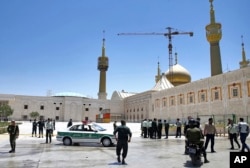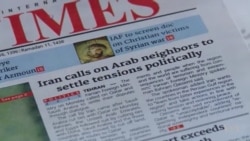Iran's Intelligence Ministry said Thursday that five of the men involved in attacks on the country's parliament and the tomb of former leader Ayatollah Ruhollah Khomeini were Iranians who had joined the Islamic State group.
The ministry said the men had fought for Islamic State in Mosul, Iraq, and in Raqqa, Syria, before returning to Iran in August of last year.
Iranian officials also raised the death toll in Wednesday's attack, saying at least 17 people were killed and 40 wounded.
The near simultaneous attacks by machine-gun wielding assailants and two suicide bombers were claimed almost immediately by Islamic State, and could set off a new round of hostilities in an already tense Middle East.
In a new twist, the terror group’s Amaq news agency also quickly distributed a 24-second video of the attack showing a bloody, lifeless body inside the parliament complex, and threatened it would strike again.
Iranian security officials late Wednesday confirmed IS involvement, saying the attackers, many disguised as women, were Iranians who had joined the terror group.
Attackers
The officials said Iranian forces killed six of the attackers. Another five suspects were arrested, and two suicide bombers blew themselves up. Officials suggested a third attack had been foiled.
“These fireworks have no effect on Iran,” Supreme Leader Ayatollah Ali Khamenei told state-run television, vowing the terrorists “will soon be eliminated.”
Islamic State and Iran have long been at odds, with IS fighters facing off against Iranian proxies and Iranian-led forces in Syria and Iraq. But Wednesday’s attacks marked the first by the Sunni terror group in the majority Shi’ite country.
U.S. intelligence called the incident the worst domestic terror attack in Tehran since the 1980s, but an official said there have been signs IS was, at least, hoping to strike.
“ISIS has expressed a growing interest in conducting attacks on the Iranian homeland,” the official said, using an acronym for the militant group.
And pointing to increasingly virulent propaganda over the past six months, the official added it had become clear “Iran has been at the top of ISIS’ enemy list.”
Still, Iranian officials immediately placed the ultimate blame on Saudi Arabia.
“This terrorist attack happened only a week after the meeting between the U.S. president and the [Saudi] backward leaders who support terrorists,” according to statement by Iran’s Revolutionary Guard Corps. “The fact that Islamic State has claimed responsibility proves that they were involved in the brutal attack.”
Watch: Iranians Support Qataris, Blame US For Tensions in Middle East
World reaction
Condemnation for the attacks poured in from around the world.
The United Nations Security Council said the attacks were “barbaric and cowardly” and stressed that it condemned the attacks “in the strongest terms.”
Russian President Vladimir Putin sent condolences and offered assistance
In a statement, President Donald Trump said the U.S. grieves and prays for “the innocent victims” of the attacks, and “the Iranian people, who are going through such challenging times.”
But Trump also warned “states that sponsor terrorism risk falling victim to the evil they promote.”
Iran’s Foreign Minister Mohammad Javad Zarif responded on Twitter, criticizing both Trump’s words and the U.S. Senate moving closer to new sanctions against Iran.
“Repugnant WH statement & Senate sanctions as Iranians counter terror backed by U.S. clients. Iranian people reject such U.S. claims of friendship,” Zarif wrote.
Middle East tensions
Tensions have been running high across the Middle East, where Iran and Saudi Arabia have long vied for prominence and influence, including in Yemen where the rivals have been locked into a proxy war.
The region has further put been on edge following a decision by key Arab powers to cut ties with Qatar, accusing the government in Doha of supporting terror groups and of aligning too closely with Iran.
Some analysts fear Wednesday’s terror attack in Tehran could prompt a harsh response by Iran, at home and perhaps even across the region.
At least initially, though, Iran’s proxy forces have been quiet on social media.
“It’s reminiscent of when some IS bombs have hit Baghdad or other parts of Iraq,” said Phillip Smyth, a University of Maryland researcher who closely follows Shi’ite militia activity. “Often there is little reaction and the groups continue to talk about their efforts.”
Some of the groups issued condolences, Smyth said, though one Tehran-based account called it a “blueprint of [how] Zionist, Gulf-Saudi, and American terrorism [is exported] to Iran.”












